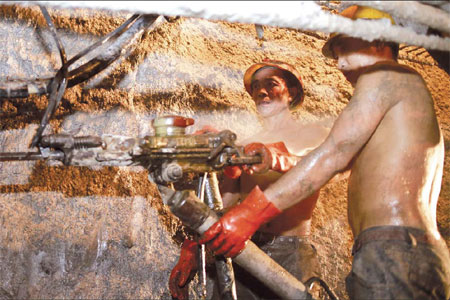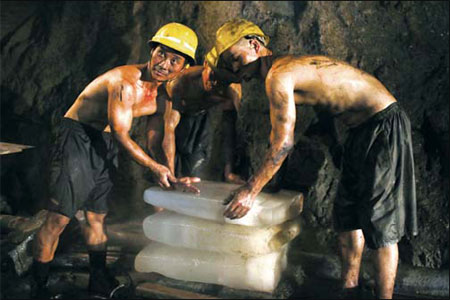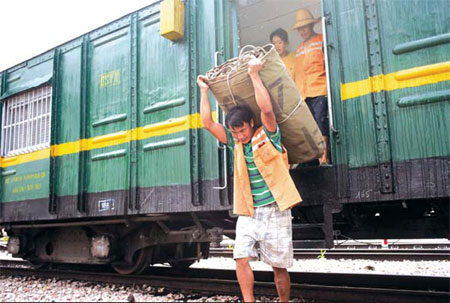Tunnel builders sweat it out on new rail line
Updated: 2013-07-04 07:56
By Hu Yongqi (China Daily)
|
||||||||
|
Workers in the Taiyangzhai tunnel, one of six tunnels longer than 5 km, on a key section of the railway connecting Hekou and Mengzi in Yunnan province. Photos by Feng Yongbin / China Daily |
|
Xiang Jinyue, 7, sings as she travels with her grandparents on the Kunming-Mengzi train. |
|
Workers use ice to lower the temperature in the Taiyangzhai tunnel. |
|
A worker unloads goods from a Vietnamese train at Shanyao station. |
Conditions are harsh for workers on regional link, reports Hu Yongqi in Honghe, Yunnan
Most people search for a shady spot to avoid direct exposure to the mid-June sun that pushes temperatures to 39 C in Hekou Yao autonomous county bordering Vietnam.
However, Xie Yunchuan, 29, found the searing heat far more bearable than that in his place of work, the Taiyangzhai railway tunnel, where the temperature often rises to 43 C.
The trees glowed golden in the sunshine and the cicadas whirred to "express their antipathy to the hot weather", as a local saying goes. Feeling in need of refreshment, Xie hopped onto his motorcycle and headed off for lunch at an air-conditioned house nearby.
Inside the tunnel, air barely circulates, and Xie and his co-workers adopt measures to avoid suffocation and heatstroke, taking a break every two or three hours while another team continues the work.
"In many tunnels I've worked in, it's usually been quite cold inside. This is the first time I've encountered such high temperatures," he said.
The conditions mean the workers perspire more than usual. To avoid dehydration, Xie and his fellow workers have figured out how to make a refreshing, and possibly lifesaving, drink. They mix sugar, salt and tea and then place the concoction in the fridge before starting work.
Meanwhile, their company, the Fifth Bureau Group Corporation of China Railway, has spent 200,000 yuan ($32,600) on construction of an icehouse close to the entrance of the tunnel.
During every shift, six metric tons of ice are carried inside to lower the temperature in the tunnel, which will be 7,354 meters in length when completed. Despite working for four years, the team still has another 280 meters to drill before the tunnel will be finished, according to Jiang Jun, deputy head of the construction team.
The Taiyangzhai tunnel is a key part of the Mengzi-Hekou Railway, connecting Hekou Yao autonomous county and Mengzi, the capital of Honghe Hani and Yi autonomous prefecture in Yunnan province.
Upon completion next year, the 468-kilometer-long railway will reduce the current eight hour journey between Kunming, the provincial capital, and Hekou by half, according to Kunming Railway Bureau.
In the bigger picture, the Mengzi-Hekou Railway is the last component of a project that constitutes the eastern line of the Pan-Asia Railway, a crucial link between Southwest China and several Southeast-Asian countries.
Three new lines
The network will have three lines, eastern, central and western, and will run from Kunming to Singapore.
The eastern line will run from Kunming, via Mengzi and Hekou, in Yunnan, to Hanoi and Ho Chi Minh City in Vietnam. It will then continue on to Phnom Penh in Cambodia, Bangkok in Thailand, Kuala Lumpur in Malaysia, and right through to Singapore, its final destination.
The western line will travel through Dali and Ruili in Yunnan province, to Yangon in Myanmar and then on to Bangkok. The section between Kunming to Dali has already been completed.
The central line will run from Kunming to Jinghong, also in Yunnan. Later, if negotiations are successful, it will progress at Vientiane, the capital of Laos, and then Bangkok.
The new network will replace the existing Yunnan-Vietnam Railway, which is solely a cargo route between the two countries. However, the railway's low speed had long impeded bilateral trade.
The Mengzi-Hekou Railway, designed to run at 120 km per hour, will improve the transport capacity of Sino-Vietnamese trade and also aid exchanges among other Southeast-Asian countries. The railway authorities and local residents are confident that the new network will bring advantages to the region.
So far, 64 percent of the new Mengzi-Hekou Railway has been completed. The 143-km-railway, which will carry both passengers and cargo, is scheduled to begin operating in late 2014, according to Kunming Railway Bureau.
The line will have 32 tunnels and 36 bridges, accounting for 76 percent of its total length. So far, 29 of the tunnels have been completed, but the construction teams still have 4,858 meters of tunnel left to drill, the bureau said.
Taiyangzhai is one of six tunnels longer than 5 km. Their construction has presented the team with huge challenges, both physical and mental.
On June 22, Xie and 10 of his co-workers were sitting next to three large blocks of ice produced in the icehouse at the tunnel entrance. "Every 40 or 50 minutes, we must stop for a while and come out to cool off," said Guo Xinghai, 33.
The tunnel burrows through a chain of hills that rises to an average height of 500 meters. A 450-meter-long relief line, set at an angle of 45 degrees to the main shaft, carries away the broken rock and other waste from the construction process. The air in the main tunnel often becomes stagnant and the temperature soars whenever the boring machine is in operation. When the workers were reinforcing the walls, the fresh concrete gave out more heat and the temperature often rose to 45 C, said Jiang.
Even when the workers were motionless, it was easy to see the sweat drenching their skin despite the half-light in the wide tunnel. When a couple of colleagues and I visited the site to witness the construction work on June 23, we found it hard to breath after just 30 minutes in the tunnel. At a width of more than 3 meters, it can easily accommodate the motorcycles that some of the workers use to save time getting in and out.
The suffocating atmosphere has scared Jiang many times, but never more than when workers faint and fall limply to the ground. They are always sent for treatment at the nearest hospital, about 40 km distant. "I have fainted in the tunnel three times and on one extreme occasion I knew I was falling, but my body wouldn't follow my mind," he said.
Jiang ordered the workers to install air blowers to lower the temperature: "However, because the tunnel is 3.5 kilometers long, the two air blowers were unable to provide fresh air, and so we spent a further 100,000 yuan to install six more."
"Last week, when three workers fainted, they were foaming at the mouth. I was really scared. What if someone died in the tunnel? The conditions mean that many of the workers quit after just a short time. They say, 'I prefer having my life to having money'. The harsh conditions mean being safe is more important than earning cash."
Jiang has 10 "brother" workers who have helped him build tunnels on a number of important railway lines, such as the Wuhan-Guangzhou High-Speed Railway.
Other than these stalwarts, Jiang regards some of the other workers as migratory birds - since construction began, 1,000 of them have left the site after just one or two days.
Testing conditions
At other construction sites, problems, such as complicated rock formations and unpredictable subterranean water leakage, have tested the construction team's patience and technical skill, said He Huaijiao, the program manager for the Pingzhai Tunnel and the Mayinghe Bridge in Pingbian Miao autonomous county.
Three years ago, the workers experienced their largest washout when approximately 3,000 cubic meters of water gouged a huge depression in the floor of the tunnel. "There was no way to fix it, so we made a concrete bridge that covered the hole and allowed workers and vehicles through," said He. "Even with three pumps running 24 hours a day, we were unable to drain the water completely."
Because of the humidity and heat inside the tunnel, the workers were supplied with liquid cooling garments, which direct body heat away from the wearer. However, the 20-kilogram garments proved cumbersome and the men reverted to traditional methods and simply stripped down to their underclothes during their shifts.
The Yuxi-Mengzi Railway became operational in April, trimming the journey time from Kunming to Mengzi to just four hours, and providing fast passage for goods between China and Vietnam.
At Mengzi North Railway Station, fertilizers and construction materials, Kunming and Yuxi's main exports to Vietnam, were loaded onto the trains. As an important part of the eastern line of the Pan-Asian Railway, the Mengzi-Hekou Railway will continue the role once played by the Yuxi-Mengzi Railway.
Yunnan's original railway network connected with the Yunnan-Vietnam Railway, built by the French government in the early 1900s. However, the 1-meter-wide track only allowed diesel locomotives to travel at a speed of 20 km per hour, meaning it took at least two days to carry cargo along the 468 km between Hekou and Kunming.
On the afternoon of June 24, two trains carrying fertilizer from Kunming arrived at Shanyao station, the transit point for Sino-Vietnamese trade, located 6 km from Hekou. One hour later, a Vietnamese locomotive pulling empty wagons arrived at the station. Once the customs procedures were completed, Vu Vu Quang, a Vietnamese border officer, took control of the trains for the Vietnamese stage of their journey. The wagons would be handed back on the next trip.
China's old diesel locomotives had 16 cars that could carry 30 tons of goods, only half the capacity of the trains that run on the new railway, which operates on the international standard gauge of 1.4 meters.
Import-export
In the first six months of this year, 182 trains carrying 5,463 tons of goods, mostly fertilizers and other industrial products, left Shanyao for Vietnam. At Hekou, tropical fruit and other agricultural produce are the most popular imports from Vietnam and have to reach Kunming within one day.
Qu Hongli, a transfer worker at Shanyao station, said the old trains were too slow to meet demand, and most goods were transported by road instead.
"I've been working at this station for 21 years and I remember the peak time when groups of businessman came to collect their purchases," she said, adding that in 1995 the daily exchange of goods at the station was equal to the present monthly volume.
"Vietnam still runs the narrow-gauge 1-meter-wide railway and so there has to be a transit station with track of equivalent gauge inside our borders," she said.
The Yuxi-Mengzi and Mengzi-Hekou Railways will act as a convenient link between China and Southeast-Asian markets, further strengthening cooperation and trade between China and other Southeast Asian countries, especially Vietnam, said Duan Gang, president of the Yunnan Institute of Economic Research.
Liu Baisheng, director of the Kunming Railway Bureau, said: "The Yuxi-Hekou Railway will help to improve the railway network and promote railway transport. In the future, Southwest China, especially Yunnan, will rely on the eastern line of the Pan-Asian Railway to accelerate integration with global markets, especially those in Southeast-Asia."
Li Yingqing and Guo Anfei contributed to this story.
Contact the writer at huyongqi@chinadaily.com.cn
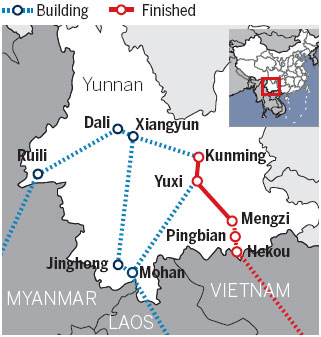
(China Daily USA 07/04/2013 page7)

 Ecuador finds spy mic for Assange meeting
Ecuador finds spy mic for Assange meeting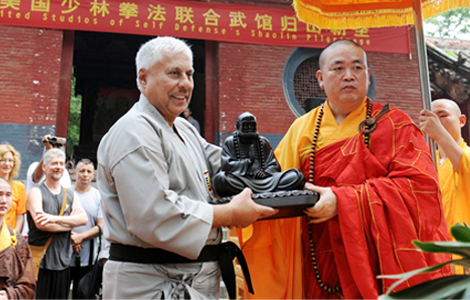
 US martial artists arrive at Shaolin Temple
US martial artists arrive at Shaolin Temple
 July 4 in Prescott: Balance of grief, patriotism
July 4 in Prescott: Balance of grief, patriotism
 Jubilant crowds celebrate after Mursi overthrown
Jubilant crowds celebrate after Mursi overthrown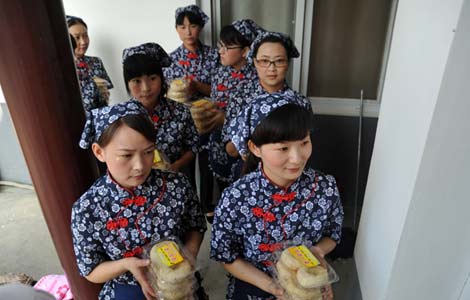
 Growth slowing for services
Growth slowing for services
 Venezuela eyed as Snowden seeks asylum
Venezuela eyed as Snowden seeks asylum
 Anti-terror drill staged in Xinjiang
Anti-terror drill staged in Xinjiang
 Memorial service held for 19 Arizona firefighters
Memorial service held for 19 Arizona firefighters
Most Viewed
Editor's Picks

|

|

|

|

|

|
Today's Top News
US welcomes China's engagement in Africa
Data show shifts in US, China economies
Obama, Merkel agree talks on surveillance program
Filipino executed for drug trafficking
Obama orders US to review aid to Egypt
Snowden still in Moscow
China urges more efficient uses of fiscal funds
Egypt army topples president Morsi
US Weekly

|

|
